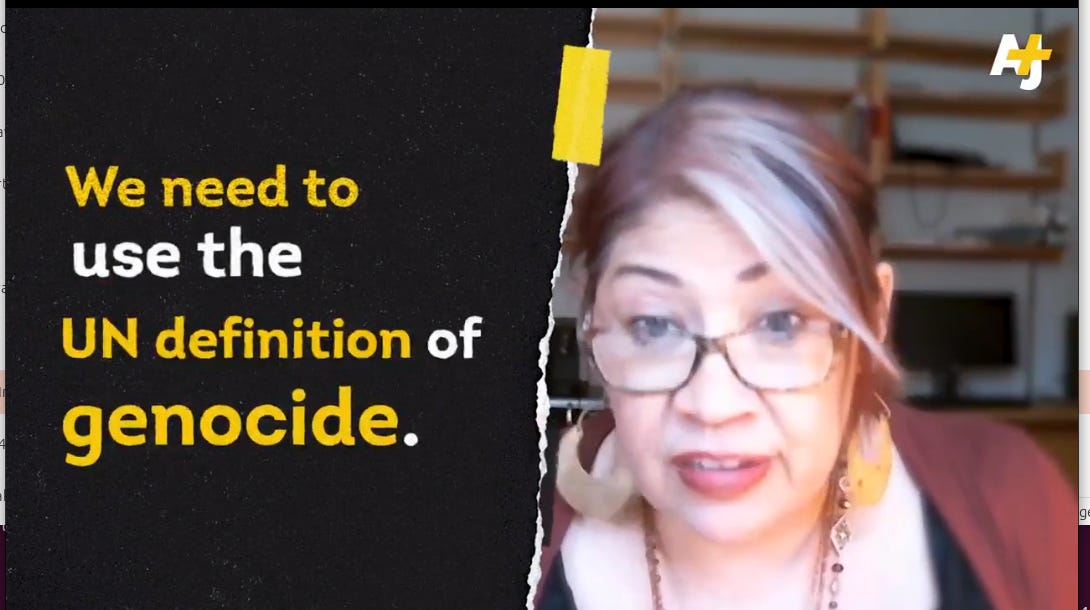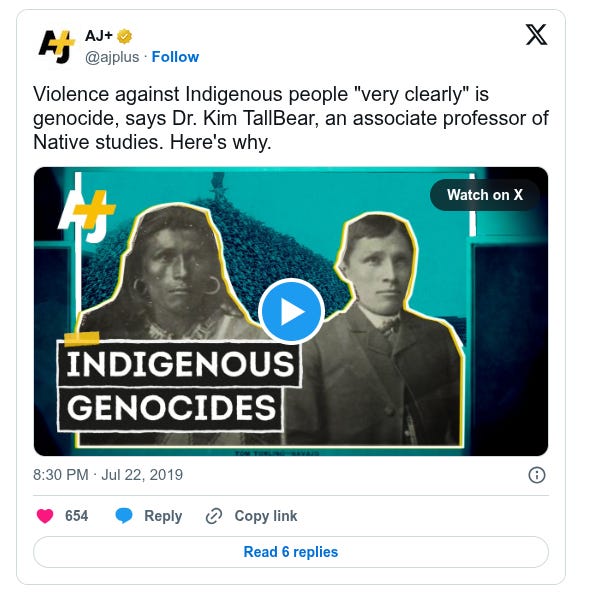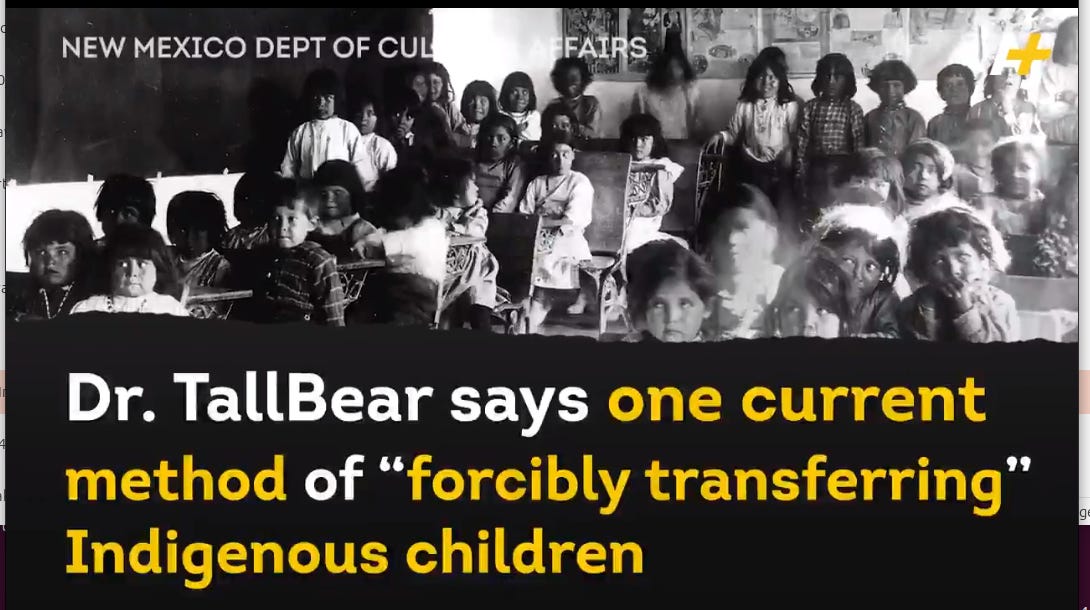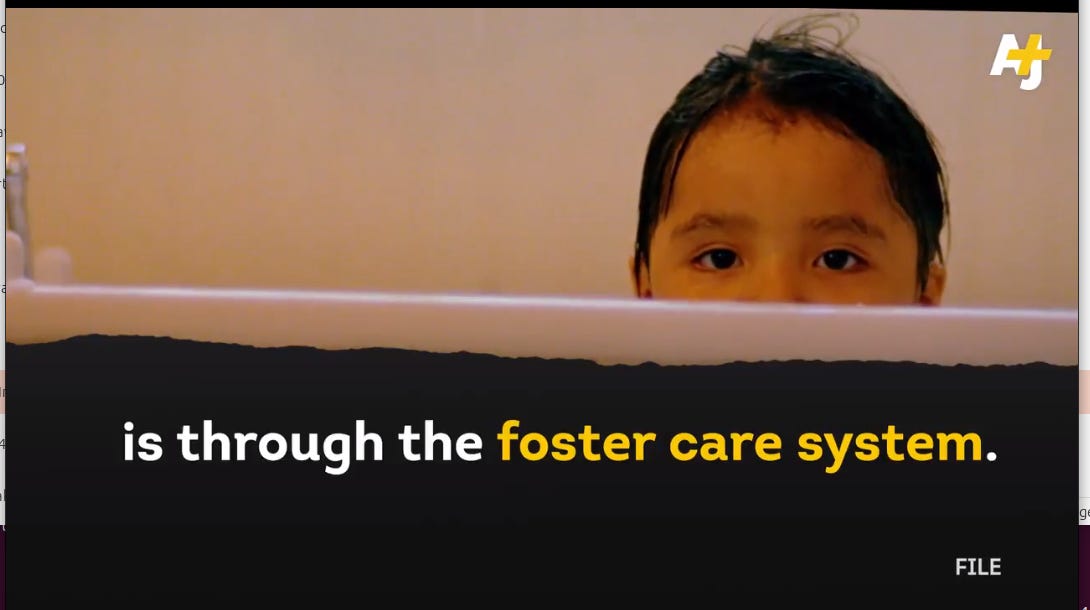Violence against Indigenous people "very clearly" is genocide
National Day for Truth and Reconciliation 2025
Each year, the Canadian Government uses September 30 to mark a National Day for Truth and Reconciliation. The Canadian Government wishes to focus on the “residential school” system that would more honestly be known as Forced Child Labour Reeducation Camps. The last of these schools closed in 1996, so the government is now comfortable talking about a specific technicque that recently ended.
While that specific technique ended, the policy has not. Genocidal policies continue, only using different specific techniques over time.
A video primer
In the summer of 2019, AJ+ English worked on a video with Dr. Kim Tallbear, then an associate professor (now professor since 2020) in the Faculty of Native Studies at the University of Alberta.
Unfortunately, due to Canadian Government policy anything alleged to be “news” isn’t available to Canadians on Meta platforms including Facebook or Instagram. The video seems to have been taken down from YouTube, never uploaded to TikTok and not available on AJPlus.net.
The video is still available on Elon Musk’s X (twitter at the time the viceo was posted), but we don’t know how long that will last.
https://x.com/ajplus/status/1153462229435596801
What is the main message?
The main message is that the genocidal policies of the Dominion of Canada governments against Indigenous Peoples (note the “s” – this isn’t about individuals, and there are far more than one “genos” involved) goes beyond the Residential School program and is ongoing.
This is not something that can be located in the past, as if the only date that matters is when a policy starts. The most important date to consider is when a policy ends, and restitution is completed. The settler-colonial and genocidal policies of the Dominion of Canada have not ended.
(See note discussing how Canada’s ongoing “ (e) Forcibly transferring children of the group to another group” discussed in the genocide convention is very similar to what Canada is trying to call-out Russia for also doing for a much shorter amount of time).
Why do we keep hearing about “cultural genocide” as being separate?
Governments like Canada and the United States want people to believe that Genocide is only about the efficient murder of individuals. This is not what the UN genocide convention says, nor is it what the concept of genocide was intended to talk about prior to governments like Canada and the USA compromising the process and creating a weaker convention.
The 1948 Convention on the Prevention and Punishment of the Crime of Genocide currently includes the wording:
In the present Convention, genocide means any of the following acts committed with intent to destroy, in whole or in part, a national, ethnical, racial or religious group, as such:
As someone who thinks in terms of Systems Theory, I immediately notice something unusual which is that “national” most often is a focus on institutions, while “ethnical, racial or religious” are more about a peoples (race or tribe - notice the “s”, as this isn’t merely a group of individuals). The greek word “genos” (race or tribe), adding the Latin suffix “-cide” for killing, is where the word genocide comes from, said to be first used by Raphael Lemkin.
Why is “national” included?
I asked ChatGPT about the inclusion of “national”, there was quite a bit in that reply that is worth thinking about:
🧠 Does “National” Fit the Meaning of Genos?
Linguistically: Not precisely.
A nation can be a political entity or identity that may not map cleanly onto genos (a concept more about bloodline, kinship, or tribe).
Nations can be multiethnic or civic constructs, not necessarily tied to lineage or faith.
So you’re correct — the inclusion of “national” stretches the term genos beyond its classical meaning.
🗣️ Lemkin’s Own Writings
Interestingly, Lemkin himself took a broader view of genos. In his 1944 book Axis Rule in Occupied Europe, he wrote:
“Genocide does not necessarily mean the immediate destruction of a nation, except when accomplished by mass killings... It is intended rather to signify a coordinated plan... aimed at the destruction of the essential foundations of the life of national groups...”
So for Lemkin, “national group” was central to the idea of genocide — but he defined it culturally and socially, not purely in political terms.
Raphael Lemkin was himself a Zionist, which would have made his own thinking complex given the desire to correctly call out the Ottoman genocide of Armenians and Nazi policies in Eastern Europe, where entire national identities were targeted, and yet not question Zionism.
When discussing settler-colonialism you are discussing the imposition of a “nation” on top of (crushing) existing peoples (genos – ethnical, racial or religious groups), putting those political institutions outside the cultural and social concept of “nation” that would exist in the context of Armenia or Poland.
This is consistent with what I have continued to read elsewhere about discussions around Israel/Palestine, which is that settlers within CANZUS (Canada, Australia, New Zealand, United States) see themselves in Israel, but Indigenous peoples of those lands see themselves in Palestine.
See also: Settler Moves to Indigeneity: From Canada to Israel
(Side-note: The situation under the Canadian governments is different from the modern Government of Israel in that there are many peoples who could be seen as Indigenous to the Levant region, including the smaller region claimed to be Palestine. The issue in that case is that one political group has claimed exclusivity against all other Indigenous peoples, and is engaged in extreme violence, war crimes and genocidal policies to remove all other peoples who have claims to indigeneity. In the case of Canada, settlers have no legitimate claims to indigeneity at all.)
The term “culture” was intended to be part of the convention
The term “culture” was intended to be in that list, which more clearly fits within a “genos”, but Canada was one of many “nations” (settler-colonial institutions) that lobbied hard against this.
This is discussed in several articles, including Behind Canada’s Decades-Long Scheme To Avoid Genocide Punishment which includes:
In a July 1948 diplomatic cable — approved by then-foreign affairs minister, and later Nobel Peace prize winner, as well as Canadian prime minister, Lester Pearson — sent to the Canadian UN delegation, the government made its position clear: “You should support or initiate any move for the deletion of Article three on ‘Cultural’ Genocide. If this move not successful, you should vote against Article three and if necessary, against the Convention. The Convention as a whole less Article three, is acceptable, although legislation will naturally be required to implement the Convention.” (The cable was dug up by researcher Edward Sadowski, and previously reported by the National Post. Sadowski kindly provided a copy to Passage.)
The inclusion of “national” and removal of “culture” from the convention made it much weaker and inconsistent than it would have been. The interests of the institutions of “nations” are covered in other UN conventions and treaties including the UN charter itself.
All that said, it remains incorrect to claim that Canada’s ongoing genocidal policies are merely “cultural”, given there is a wide variety of ethnical, racial or religious groups within what are considered the Indigenous Peoples of this land, and Canada itself uses the term “First Nations” (even if incorrectly to refer only to Indian Act Band Councils created/regulated/funded by the Canadian government itself).








"What do Princess Diana, Mother Teresa, and Canadian Indian Residential Schools have in common? They all died in 1997. No, that’s not a typo; the last Residential School (Kivalliq Hall in Rankin Inlet, Nunavut) shut down the same year Titanic hit theatres. That means the government continued to commit genocide in front of our eyes for more than a decade after we had access to cellphones and the internet."
https://payyourrent.ca/the-complete-truth-before-reconciliation/